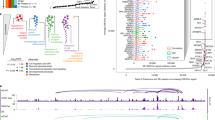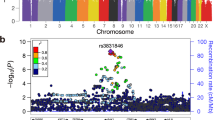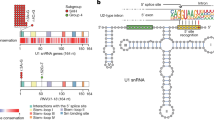Abstract
Neuroblastoma is a paediatric malignancy that typically arises in early childhood, and is derived from the developing sympathetic nervous system. Clinical phenotypes range from localized tumours with excellent outcomes to widely metastatic disease in which long-term survival is approximately 40% despite intensive therapy. A previous genome-wide association study identified common polymorphisms at the LMO1 gene locus that are highly associated with neuroblastoma susceptibility and oncogenic addiction to LMO1 in the tumour cells1. Here we investigate the causal DNA variant at this locus and the mechanism by which it leads to neuroblastoma tumorigenesis. We first imputed all possible genotypes across the LMO1 locus and then mapped highly associated single nucleotide polymorphism (SNPs) to areas of chromatin accessibility, evolutionary conservation and transcription factor binding sites. We show that SNP rs2168101 G>T is the most highly associated variant (combined P = 7.47 × 10−29, odds ratio 0.65, 95% confidence interval 0.60–0.70), and resides in a super-enhancer defined by extensive acetylation of histone H3 lysine 27 within the first intron of LMO1. The ancestral G allele that is associated with tumour formation resides in a conserved GATA transcription factor binding motif. We show that the newly evolved protective TATA allele is associated with decreased total LMO1 expression (P = 0.028) in neuroblastoma primary tumours, and ablates GATA3 binding (P < 0.0001). We demonstrate allelic imbalance favouring the G-containing strand in tumours heterozygous for this SNP, as demonstrated both by RNA sequencing (P < 0.0001) and reporter assays (P = 0.002). These findings indicate that a recently evolved polymorphism within a super-enhancer element in the first intron of LMO1 influences neuroblastoma susceptibility through differential GATA transcription factor binding and direct modulation of LMO1 expression in cis, and this leads to an oncogenic dependency in tumour cells.
This is a preview of subscription content, access via your institution
Access options
Subscribe to this journal
Receive 51 print issues and online access
$199.00 per year
only $3.90 per issue
Buy this article
- Purchase on Springer Link
- Instant access to full article PDF
Prices may be subject to local taxes which are calculated during checkout



Similar content being viewed by others
Accession codes
Primary accessions
Gene Expression Omnibus
Data deposits
ChIP-seq data sets are available under Gene Expression Omnibus (GEO) super series GSE65664, and relevant accession numbers are shown in Supplementary Table 2.
References
Wang, K. et al. Integrative genomics identifies LMO1 as a neuroblastoma oncogene. Nature 469, 216–220 (2011)
Maris, J. M. et al. Chromosome 6p22 locus associated with clinically aggressive neuroblastoma. N. Engl. J. Med. 358, 2585–2593 (2008)
Diskin, S. J. et al. Copy number variation at 1q21.1 associated with neuroblastoma. Nature 459, 987–991 (2009)
Capasso, M. et al. Common variations in BARD1 influence susceptibility to high-risk neuroblastoma. Nature Genet. 41, 718–723 (2009)
Nguyễn lễ, B. et al. Phenotype restricted genome-wide association study using a gene-centric approach identifies three low-risk neuroblastoma susceptibility loci. PLoS Genet. 7, e1002026 (2011)
Diskin, S. J. et al. Common variation at 6q16 within HACE1 and LIN28B influences susceptibility to neuroblastoma. Nature Genet. 44, 1126–1130 (2012)
Diskin, S. J. et al. Rare variants in TP53 and susceptibility to neuroblastoma. J. Natl. Cancer Inst. 106, dju047 (2014)
Matthews, J. M., Lester, K., Joseph, S. & Curtis, D. J. LIM-domain-only proteins in cancer. Nature Rev. Cancer 13, 111–122 (2013)
Mathelier, A. et al. JASPAR 2014: an extensively expanded and updated open-access database of transcription factor binding profiles. Nucleic Acids Res. 42, D142–D147 (2014)
Deng, W. et al. Controlling long-range genomic interactions at a native locus by targeted tethering of a looping factor. Cell 149, 1233–1244 (2012)
Creyghton, M. P. et al. Histone H3K27ac separates active from poised enhancers and predicts developmental state. Proc. Natl Acad. Sci. USA 107, 21931–21936 (2010)
Hnisz, D. et al. Super-enhancers in the control of cell identity and disease. Cell 155, 934–947 (2013)
Sanda, T. et al. Core transcriptional regulatory circuit controlled by the TAL1 complex in human T cell acute lymphoblastic leukemia. Cancer Cell 22, 209–221 (2012)
Chipumuro, E. et al. CDK7 inhibition suppresses super-enhancer-linked oncogenic transcription in MYCN-driven cancer. Cell 159, 1126–1139 (2014)
Parker, S. C. et al. Chromatin stretch enhancer states drive cell-specific gene regulation and harbor human disease risk variants. Proc. Natl Acad. Sci. USA 110, 17921–17926 (2013)
Puissant, A. et al. Targeting MYCN in neuroblastoma by BET bromodomain inhibition. Cancer Discov. 3, 308–323 (2013)
Sur, I., Tuupanen, S., Whitington, T., Aaltonen, L. A. & Taipale, J. Lessons from functional analysis of genome-wide association studies. Cancer Res. 73, 4180–4184 (2013)
Whyte, W. A. et al. Master transcription factors and mediator establish super-enhancers at key cell identity genes. Cell 153, 307–319 (2013)
Henderson, T. O. et al. Racial and ethnic disparities in risk and survival in children with neuroblastoma: a Children’s Oncology Group study. J. Clin. Oncol. 29, 76–82 (2011)
Latorre, V. et al. Replication of neuroblastoma SNP association at the BARD1 locus in African-Americans. Cancer Epidemiol. Biomarkers Prev. 21, 658–663 (2012)
Mansour, M. R. et al. Oncogene regulation. An oncogenic super-enhancer formed through somatic mutation of a noncoding intergenic element. Science 346, 1373–1377 (2014)
Lee, T. I., Johnstone, S. E. & Young, R. A. Chromatin immunoprecipitation and microarray-based analysis of protein location. Nature Protocols 1, 729–748 (2006)
Marson, A. et al. Connecting microRNA genes to the core transcriptional regulatory circuitry of embryonic stem cells. Cell 134, 521–533 (2008)
Langmead, B., Trapnell, C., Pop, M. & Salzberg, S. L. Ultrafast and memory-efficient alignment of short DNA sequences to the human genome. Genome Biol. 10, R25 (2009)
Kent, W. J. et al. The human genome browser at UCSC. Genome Res. 12, 996–1006 (2002)
Zhang, Y. et al. Model-based analysis of ChIP-Seq (MACS). Genome Biol. 9, R137 (2008)
Li, H. et al. The Sequence Alignment/Map format and SAMtools. Bioinformatics 25, 2078–2079 (2009)
Lovén, J. et al. Selective inhibition of tumor oncogenes by disruption of super-enhancers. Cell 153, 320–334 (2013)
Nakatani, Y. & Ogryzko, V. Immunoaffinity purification of mammalian protein complexes. Methods Enzymol. 370, 430–444 (2003)
Durbin, A. D. et al. JNK1 determines the oncogenic or tumor-suppressive activity of the integrin-linked kinase in human rhabdomyosarcoma. J. Clin. Invest. 119, 1558–1570 (2009)
Acknowledgements
This work was supported in part by NIH grants R01-CA124709 (J.M.M.), R01-CA180692 (J.M.M. and A.T.L.), R00-CA151869 (S.J.D.), RC1MD004418 to the TARGET consortium, 1K99CA178189 (S.Z.), T32-HG000046 (D.A.O.), R01-CA109901 (R.A.Y.), the Giulio D’Angio Endowed Chair (J.M.M.), the PressOn Foundation (J.M.M.), Andrew’s Army Foundation (J.M.M.), the Abramson Family Cancer Research Institute (J.M.M.), the Brooke Mulford Foundation (J.M.M.), the University of Pennsylvania Genome Frontiers Institute, an Alex’s Lemonade Stand Foundation Innovation Award (A.T.L.), young investigator awards from Alex’s Lemonade Stand Foundation (S.Z., A.C.W.) and the CureSearch for Children’s Cancer Foundation (S.Z.), grant from the German Cancer Aid 110801 (N.W.-L.), St Baldrick’s Foundation Fellow award (A.C.W.), George L. Ohrstrom Jr foundation (A.C.W.), Wellcome Trust Senior Investigator Award Ref:100210/Z/12/Z (N.R.) and NHS funding to the NIHR Biomedical Research Centre at The Royal Marsden and the ICR (N.R.), Fondazione Italiana per la Lotta al Neuroblastoma (M.C.), Associazione Oncologia Pediatrica e Neuroblastoma (M.C.), and Associazione Italiana per la Ricerca sul Cancro (M.C.). We gratefully acknowledge the Children’s Oncology Group (COG) for providing the specimens and clinical data from neuroblastoma patients and thank patients and families for participating in the COG, the UK-based Factors Associated with Childhood Tumors (FACT), and Italian cooperative group studies. We thank A. Renwick who performed the Taqman analyses and A. Zachariou for recruiting participants to the FACT study. We thank G. Blobel for scientific advice and discussion, and generously providing equipment and reagents for ChIP experiments, N. Saeki and H. Sasaki for providing the LMO1 cDNA clone, and Y. Nakatan for providing the lentiviral vector pOZ-FHN.
Author information
Authors and Affiliations
Contributions
J.M.M. and A.T.L. conceived the study, guided interpretation of results and guided preparation of the manuscript. D.A.O. and A.C.W. performed and/or oversaw most of the experiments, computational analyses and data interpretation. I.C., R.S., C.W., L.S.H., S.Z., N.W.-L., A.D.D., B.J.A., L.A., L.T., K.B. and R.A.Y. performed the genomic and epigenetic experiments and data analysis including DNA sequencing and ChIP sequencing. L.D.M., S.J.D. and H.H. performed the fine mapping and association testing. J.S.W. and J.K. performed the tumour RNA sequencing. N.R. and M.C. performed the validation genotyping and association testing. M.C. and A.I. replicated the SNP association in the Italian cohort. D.A.O. and A.C.W. drafted the manuscript, while A.T.L. and J.M.M. and other authors edited the manuscript.
Corresponding author
Ethics declarations
Competing interests
The authors declare no competing financial interests.
Extended data figures and tables
Extended Data Figure 1 The imputed SNP, rs2168101, is associated with neuroblastoma, and the risk ‘G’ allele is enriched in neuroblastoma cases.
Ternary density plots of genotype probability vectors [P(G/G), P(G/T), P(T/T)] output from IMPUTE2 for rs2168101 in the European-American cohort. Vertices represent ‘perfect’ confidence calls in which P(genotype) = 1; dotted lines represent decision boundaries for genotype calling based on most probable genotype. All plots were normalized by the total number of individuals studied and subjected to 2D Gaussian kernel smoothing. Left, 2,101 cases (red); centre, 4,202 controls (blue); right, difference between cases and controls highlights enrichment of G/G genotype (homozygous risk) in cases and of G/T and T/T genotypes in controls. Validation efforts using PCR-based genotyping in 146 out of 2,101 European-American cases confirmed an 86% concordance with imputation based on most probable genotypes (Supplementary Table 1).
Extended Data Figure 2 Conditional analysis reveals a single neuroblastoma association signal at the LMO1 locus and that rs2168101 is the most associated variant.
a, Imputation-based neuroblastoma association study conditional on rs2168101. No variants remain significant after conditioning on rs2168101 (most significant variant: rs34544683, nominal P = 9.0 × 10−4, Bonferroni P = 1). b, Reciprocal analysis conditioned on each of 27 SNPs with a nominal P < 1 × 10−5. For rs2168101, the maximum (least significant) P value across all non-rs2168101 conditional tests is shown, in order to illustrate the extent to which the signal at rs2168101 can be accounted for by other variants (a similar maximum P value statistic is plotted for other variants). Notably, rs2168101 remained significant (worst-case nominal P = 2.6 × 10−7, Bonferroni P = 0.002) across all tests. These results are consistent with a single underlying signal at the LMO1 locus, and re-affirm that rs2168101 is the single best causal SNP candidate because its association with neuroblastoma cannot be accounted for by other single variants.
Extended Data Figure 3 The risk G allele of rs2168101 is associated with decreased event-free and overall survival in the European-American discovery cohort.
Because genotypes for rs2168101 are imputed within the European-American discovery cohort, the most likely genotype for each neuroblastoma case was called based on the maximum of P(G/G), P(G/T) and P(T/T) from IMPUTE2. P values reflect Cox proportional hazards regressions adjusted for MYCN amplification status and the first 20 MDS components to adjust for population stratification. a, Kaplan–Meier plot for event-free survival. Neuroblastoma cases with rs2168101 = G/G versus rs2168101 = G/T or T/T showed significantly worse event-free survival (P = 0.0004). b, Kaplan–Meier plot for overall survival. Neuroblastoma cases with rs2168101 = G/G versus rs2168101 = G/T or T/T showed significantly worse overall survival (P = 0.0004). Censored data points are shown as black crosses. Number of at risk patients at every time point for both event-free survival and overall survival are plotted below each respective Kaplan–Meier plot.
Extended Data Figure 4 rs2168101 genotype is associated with total and allele-specific LMO1 expression in neuroblastoma cell lines and primary tumours, and allele-specific expression differences are not driven by somatic DNA copy number alterations.
a, Neuroblastoma cell line LMO1 mRNA expression as quantified by Affymetrix U95Av2 oligonucleotide arrays and normalized as described11 was significantly higher in cell lines harbouring homozygous risk alleles (G/G) compared to heterozygous alleles (G/T) (P = 0.047, Mann–Whitney two-tailed). b, Allele-specific expression measured by RNA-seq from primary neuroblastoma tumours. Since rs2168101 is an intronic SNP that is spliced out in mRNA, the synonymous exonic SNP rs3750952 was used as a surrogate for measuring allele-specific expression in 39 primary tumours which are heterozygous for rs3750952 (C/G genotype). The DNA allelic fraction for rs3750952 determined by whole-exome sequencing is plotted on the x axis, whereas the RNA allele fraction for rs3750952 determined by mRNA-seq is plotted on the y axis. The solid line indicates where DNA and RNA allele fractions are equal and dotted lines indicate the boundary where DNA and RNA allele fractions are within 10% of each other. Tumours that are heterozygous for rs2168101 (G/T genotype, red dots) exhibit greater RNA allelic imbalance (P = 5.3 × 10−5) than homozygous controls (rs2168101 = G/G genotype, black dots). By contrast, DNA allelic imbalance is no different between G/T versus G/G tumours (P = 0.79), indicating that a cis-acting regulatory mechanism, rather than somatic DNA alterations, drives LMO1 allelic expression differences.
Extended Data Figure 5 Expression of LMO1 and GATA-family transcription factors in neuroblastoma primary tumours and cell lines.
a, RPKM expression measurements from mRNA-seq are summarized via boxplots for 127 primary neuroblastoma tumours for paralogues GATA1 through GATA6. Both GATA2 (median RPKM: 56) and GATA3 (median RPKM: 110) are more highly expressed by 1–4 orders of magnitude on average compared to other members of the GATA family in neuroblastoma. b, Neuroblastoma cell lines were lysed for protein and resolved by SDS–PAGE as previously described21. Jurkat T-ALL cells are shown as a positive control for LMO1 and GATA3 expression. Data are representative of at least three independent blots. The rs2168101 genotype is shown below individual cell lines.
Extended Data Figure 6 The LMO1 super-enhancer is observed in neuroblastoma cell lines containing the G allele of rs2168101 and is highly tissue-specific.
a, H3K27ac signal across all enhancers in SHSY5Y (MYCN not amplified; rs2168101 = G/G), BE2 (MYCN-amplified; rs2168101 = G/T) and NGP (MYCN-amplified; rs2168101 = G/T) is shown. Enhancers are ranked by their signal of H3K27ac minus input signal and are geometrically divided into two populations (see Methods). Super-enhancers are those at the high end of the population and are associated with key genes in neuroblastoma, highlighted on the curve. LMO1-associated super-enhancers were identified in BE2, KELLY and SHSY5Y cells, which all contain the G allele of rs2168101, but not in BE2C cells in which the G allele is absent. b, H3K27ac ChIP-seq in the Jurkat cell line. c, All ENCODE non-neuroblastoma cell lines with H3K27ac ChIP-seq profiling. All non-neuroblastoma cell lines considered showed little to no evidence for an active enhancer element within the first intron of the LMO1 gene locus, consistent with a tissue and disease-specific enhancer overlying the neuroblastoma causal SNP rs2168101.
Extended Data Figure 7 Depletion of GATA3 results in suppression of cell growth that is rescued by forced LMO1 expression in neuroblastoma.
Neuroblastoma cells SHSY5Y, KELLY, KELLY overexpressing control vector (EV) and KELLY with forced LMO1 overexpression (LMO1-1 and LMO1-2) were treated with non-targeted (siControl) or GATA3-targeting (siGATA3-1, siGATA3-2) siRNAs and cells were counted at 24, 48 and 72 h after transfection. Rescue of suppressed cell growth after GATA3 depletion by forced LMO1 expression in LMO1-1 and LMO1-2 after 72 h is shown on the bottom. Growth curves over the time of 72 h are shown (to accompany Fig. 3f). Error bars denote ±s.e.m., n = 9 technical replicates.
Supplementary information
Supplementary Information
This file contains western blots, supplementary text, Supplementary Tables 1-2 and additional references. (PDF 506 kb)
Rights and permissions
About this article
Cite this article
Oldridge, D., Wood, A., Weichert-Leahey, N. et al. Genetic predisposition to neuroblastoma mediated by a LMO1 super-enhancer polymorphism. Nature 528, 418–421 (2015). https://doi.org/10.1038/nature15540
Received:
Accepted:
Published:
Issue Date:
DOI: https://doi.org/10.1038/nature15540
This article is cited by
-
Integration of clinical characteristics and molecular signatures of the tumor microenvironment to predict the prognosis of neuroblastoma
Journal of Molecular Medicine (2023)
-
Mutations of 1p genes do not consistently abrogate tumor suppressor functions in 1p-intact neuroblastoma
BMC Cancer (2022)
-
Recent advances in the developmental origin of neuroblastoma: an overview
Journal of Experimental & Clinical Cancer Research (2022)
-
Loss of CASZ1 tumor suppressor linked to oncogenic subversion of neuroblastoma core regulatory circuitry
Cell Death & Disease (2022)
-
Advancing therapy for neuroblastoma
Nature Reviews Clinical Oncology (2022)
Comments
By submitting a comment you agree to abide by our Terms and Community Guidelines. If you find something abusive or that does not comply with our terms or guidelines please flag it as inappropriate.



